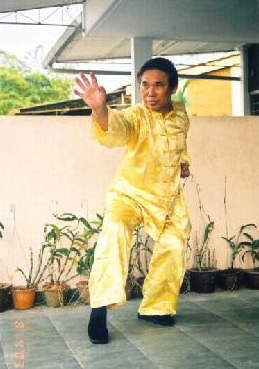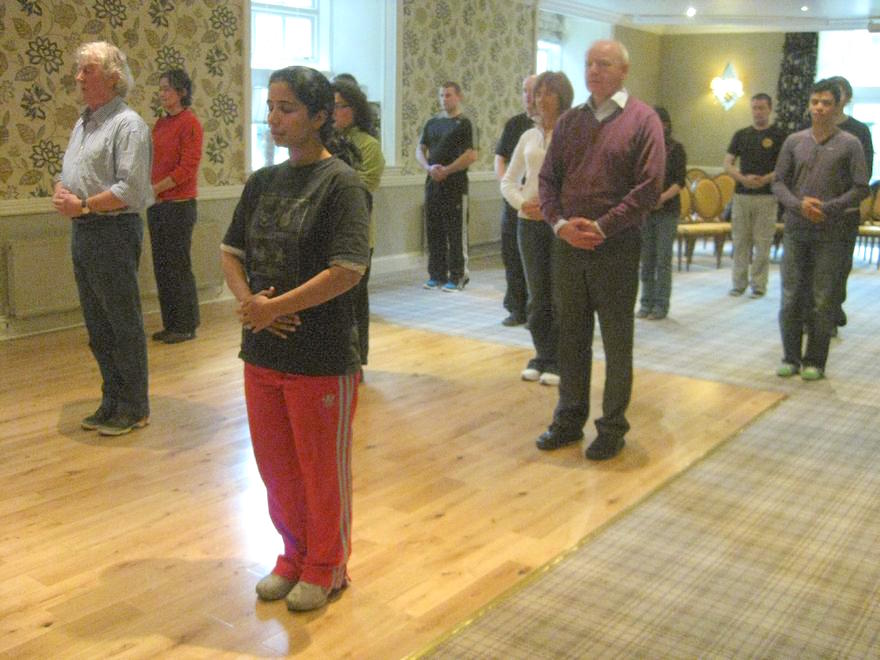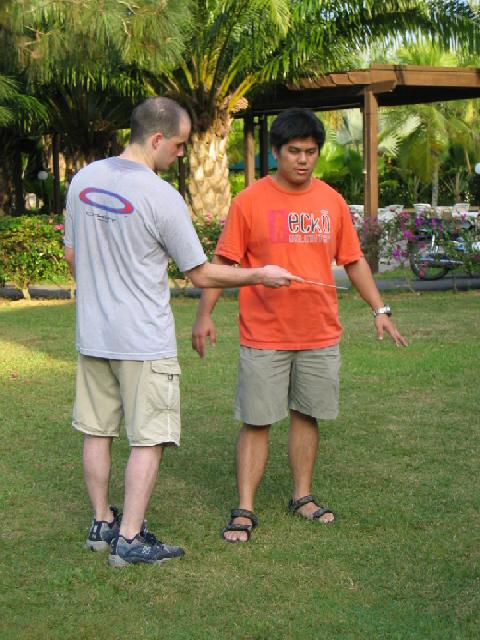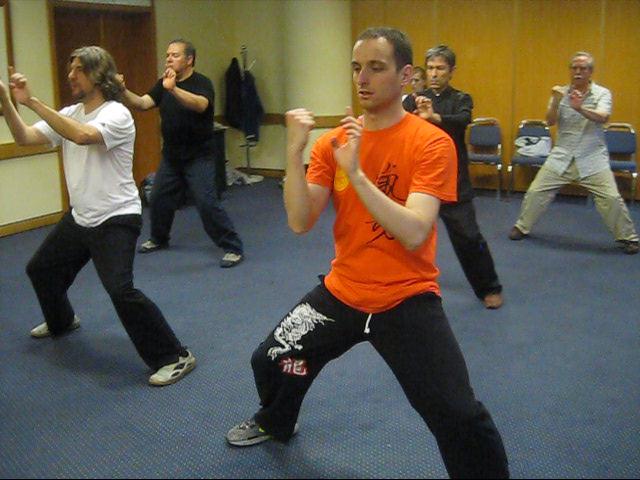SELECTION OF QUESTIONS AND ANSWERS
JANUARY 2015 PART 3

Single Tiger Emerges from Cave
Question 1
Is there any difference between Abdominal Breathing and Dan Tian Breathing?
— Jon, England
Answer
Many people use the two terms interchangeably, but we make a difference between them.
It would be interesting to briefly trace the development of how these two terms were used in our school.
When I learned abdominal breathing from Sifu Ho Fatt Nam in the early 1970s as part of my Small Universe training, it was called Abdominal Breathing, and sometimes called Dan Tian Breathing and natural breathing. When I progressed to reverse breathing at a later stage, it was called Reversed Breathing.
When I taught the Small Universe in a six-month course to advanced students in the late 1980s, I used the techniques of abdominal breathing and reverse breathing. To help students attain the Small Universe, I divided the training process into five parts as follows:
- Abdominal Breathing.
- Submerged Breathing.
- Long Breathing.
- Forceful Small Universe.
- Gentle Small Universe.
The technique of abdominal breathing was employed for Stages 1, 2, 3 and 5, and the technique of reverse breathing for Stage 4.
In abdominal breathing, the abdomen rises when an exponent breathes in, and falls when he breathes out. In reverse breathing, the abdomen falls when he breathes in, and rises when he breaths out. Then he gently sinks his energy to his dan tian.
Abdominal breathing and reverse breathing in chi kung and kungfu are often mistaken, even by masters, to be diaphragm breathing and chest breathing. They are different thought the external form may look similar.
In diaphragm breathing and chest breathing, air is breathed into and out of the lungs. The rise and fall of the abdomen is noticeable, sometimes exaggerated. In abdominal breathing and reverse breathing, energy is channeled into and out of the dan tian. The rise and fall of the abdomen is gentle, often not noticeable unless specially observed.
When I first taught abdominal breathing in regional courses in the early 2000s, the two terms, Abdominal Breathing and Dan Tian Breathing, were used interchangeably. In other words, Abdominal Breathing and Dan Tian Breathing were the same. The flow of energy was from the nose to the dan tian, and from the dan tian out of the mouth.
In the late 2000s, I upgraded Abdominal Breathing to Dan Tian Breathing, and began to use the two terms differently. The term "Abdominal Breathing" referred to energy flowing from the nose to the dan tian, and from the dan tian out of the mouth, with the nose breathing in and the mouth breathing out. The flow was vertical. The term "Dan Tian Breathing" referred to energy flowing from the cosmos to the dan tian, and from the dan tian to the cosmos without breathing in and out of the nose and mouth. The flow was spherical. Hence, Abdominal Breathing was not the same as Dan Tian Breathing.
In my own practice earlier, Abdominal Breathing spontaneously became Dan Tian Breathing after many years. The technique was the same, which was abdominal breathing, i.e. with the abdomen rising when breathing in, and the abdomen falling when breathing out. But my flow of energy gradually changed from vertical to spherical.
At the time of my own practice, I did not differentiate between technique and skill. But when I taught Abdominal Breathing and Dan Tian Breathing, I made a difference, and it sped up results unbelievably.
Then I became aware that the breathing technique in both Abdominal Breathing and Dan Tian Breathing was the same, with the abdomen rising when breathing in, and the abdomen falling when breathing out, which was in contrast with reverse breathing where the abdomen fell when breathing in, and rose when breathing out. Hence, to highlight the difference in skill, I changed the term "Dan Tian Breathing" to "Cosmic Breathing", which is very appropriate, as the exponent literally pulsates with the Cosmos.
I still use the term "abdominal breathing" (with small letters) to refer to the technique of breathing where the abdomen rises when breathing in, and the abdomen falls when breathing out, and "Abdominal Breathing" (with capital letters) to refer to the skill of breathing where energy is directed to flow from the nose to the dan tian, and from the dan tian to the mouth. To make the terms clearer, I am considering to change the technique of "abdominal breathing" to "dan tian breathing".
In other words, "Abdominal Breathing" will refer to the skill of channeling energy to flow from the nose into the abdomen, and from the abdomen out of the mouth. "Dan tian breathing" will refer to the technique of breathing where the abdomen rises when breathing in, and the abdomen falls when breathing out.
The technique of dan tian breathing is in contrast with the technique of reverse breathing. Dan tian breathing can be used to operate the skill of Abdominal Breathing and the skill of Gentle Small Universe. Reverse breathing can be used to operate the skill of Forceful Small Universe, and the skill of Phenomenal Big Universe.
All these terms may be meaningless to the uninitiated, but can be very interesting to those who have practiced the respective techniques and skills.
Question 2
You took more than two years to attain Abdominal Breathing, yet we can attain Cosmic Breathing in just one day! You also said that Cosmic Breathing was more advanced. How can this be possible?
Answer
One main reason was because at that time I did not differentiate between techniques and skills. So I had to practice the techniques for a long time to develop the skills. Only when I had the skills, I could derive the benefits, otherwise I just practiced the techniques as external forms.
Even when I had acquired the skills, I was not aware of them. Hence, my skills and subsequent benefits occurred haphazardly. It took me two years before I was successful in my Abdominal Breathing with the relevant benefits.
As I continued to practice Abdominal Breathing dedicatedly, my skills improved and my benefits were enhanced. Firstly I noticed that I was not breathing air in and out with my nose and mouth. Then I noticed that energy was flowing into and out of my body. I literally pulsated with the Cosmos. To differentiate these two arts, I called the former Abdominal Breathing, and the latter Cosmic Breathing.
Having realized the difference between skills and techniques, I shared the knowledge and benefits with my students. This sped up their results unbelievably. They would need much shorter time to develop appropriate skills from the best-chosen techniques.
More importantly I transmitted the skills to them from heart to heart. In other words, my students did not even have to practice the techniques to acquire the skills; they received the skills straight away from me. But they would need to have the technqies to receive the transmission. Once they had received the skills, they could use the skills on their own to practice the respective arts.
It is just unbelievable but true. I myself took more than two years to acquire the skills of Abdominal Breathing. My students need just a day to receive the transmission of skills from me!

Cosmic Breathing
Question 3
How important is targeting the wrist and elbow in defense patterns?
You taught us to go for these areas when intercepting hard patterns like "Immortal Emerges from Cave". However, would the defender also try to make contact at these areas for patterns like "Single Tiger"? Would he lean on the wrist or the elbow?
— Warren, South Africa
Answer
The wrist and elbow are among weak spots of a person. Hence, it is advisable to target the wrist and elbow not only in defence but also in attack, unless other factors are unfavorable for such moves. It takes more skill, for example, to target at his wrist or elbow than just randomly hitting an opponent's arm. Hence, it is easier for a beginner just to reach the arm in general than the wrist or elbow in particular in attack or defence.
Another reason why this principle of hitting the wrist or elbow is not put into practice is that not many people are aware of this principle. Indeed, today when many martial artists do not even strike an opponent's arm in attack, or ward of his attack at his arm, but merely exchanges blows generously, it is no surprise that they do not reach for the wrist or elbow.
Yes, for patterns like "Single Tiger Emerges from Cave", you can deflect an opponent's attack at his wrist or elbow. You may, if you like, grip his wrist or elbow, not just deflect his attack away.
Question 4
As I understand it, getting rid of the ego is of utmost importance as it is the part that is giving us bad moods and suffering. When there is no ego to suffer, life is so much easier!
— Adrian, Germany
Answer
When people advocate getting rid of the ego, what they mean is not to inflate self-importance excessively. They do not really mean getting rid of the ego.
When a practitioner succeeds in getting rid of the ego, he attains Enlightenment or returning to God the Holly Spirit where there is no subject and no object, no knower and the known.
When we live in the phenomenal world, the ego is important. Paying attention to the ego is the first principle of survival. If you are sick, you should pay attention to your ego, both your body and your spirit, so that you regain your good health, instead of working hard to help others despite being ill. Ironically a lot of unemployed people in the West are doing exactly this. They want to save the world when they should save themselves first.
The ego by itself is neutral. The ego can give you bad moods and suffering if you neglect it. If you cultivate correctly, like practicing genuine chi kung, the same ego will give you good moods and wholesome enjoyment.
When there is no ego, not only there is no suffering, there is also no happiness. It is incorrect to say that life is easier when there is no ego, in fact there is no life, it is just undifferentiated Void, or from another perspective, it is all Life.
Editorial Note: Adrian's other questions can be found at January 2015 Part 2 issue of the Question-Answer Series.

Demonstration of Golden Bell by Sifu Wong Chun Nga with Sifu Mark Applefold striking a chopper on him
Question 5
I'm also part of a certain spiritual school, which teaches exactly that with certain energy practices and it works astonishing well, and it complements the chi kung training tremendously (and vice versa). Also my teaching greatly improved through it. My mind is even more focused and still. I somehow assume smiling from the heart works in that direction as well, does it?
Answer
Our chi kung training will enhance anything anybody does, including your training in your spiritual school.
But you should not mix up your training in that spiritual school with your training in our school. You should also not teach what you do in that spiritual school in your Shaolin Wahnam teaching.
If you wish to teach what you have attained in that spiritual school, and if you are qualified to do so, do it separately.
Smiling from the heart, as an integral part of our chi kung training, will enhance any thing you do. Smiling from the heart makes you free and happy. When you are free and happy, you will have better result in all your endeavours.
Question 6
I would love to attend a Zen course with you. Will you come this year to Germany to teach a Zen course or a class about the Heart Sutra? That would be so amazing, Sigung.
Answer
I am not teaching a Zen course in Germany this year. But I shall teach a 36 Strategy course in Ireland, which is about application of Zen mind. Depending on your sigujie Fleur, who is the organizer, I shall probably teach a Zen course in England in June. I don't intend to teach a course on the Heart Sutra.

An Iron Wire course in Portugal
Question 7
Recently when I do chi kung I have the feeling of standing in a giant hall. No matter how small my training space is, I feel an enormous space around me -- it really feels good. I do not pay too much attention to it, but still I do wonder what this phenomenon is.
Answer
This indicates the expansion of your energy field, or in Western terms your energy body which is real.
Question 8
I was learning Golden Bell training from Sifu Kai some years ago, but dropped it after some time. Now I want to start all over again and questions for that practice arose. I have learned to have gentle chi flow and slap oneself all over the body, then hit with the fist as the first stages for golden bell training.
As we were learning Iron Wire with you in Barcelona, that one specific pattern from it (I think it is called big boss lifts bronce vessel) is a special pattern to develop Golden Bell. I now wonder which technique to use to train it? One of them or both?
Do you think it is an intelligent thing to train? For me, not having fear of being hit helps me tremendously to stay in Kung Fu form and to have a relaxed mind. I noticed this when I sparred with junior brothers and sisters with much less force, but I also understand that attack is often the better choice to train then just defense. What is your advice on that?
Answer
You should address your sifu as "Sifu" and not "Sifu Kai". Addressing him as Sifu Kai, which is the title the public calls him, will distant you from him to your disadvantage, much of which you may not realize.
For example, you may, usually unconsciously, practice what he has taught you in a way you think it should be performed instead of the way he has taught you. Almost always if a student learns from a competent teacher, and in your case it is certainly always because Kai is an excellent teacher, the way a student thinks is better is ironically inferior if he is lucky, and may bring insidious adverse effects if he is not lucky.
You were very lucky that Kai taught you his special art. You probably saw with your own eyes that he lifted up his arms to let top-level martial artists kick his exposed ribs without sustaining any injury! Just train the way he taught you.
However, for academic pleasure I shall answer you question.
"Big Boss Lifts Bronze Vessel" is a very powerful exercise. One of its functions is to develop Golden Bell. On the other hand, Golden Bell can also be developed without this exercise. "Big Boss Lifts Bronze Vessel" can also be used in conjunction with other exercises to develop Golden Bell.
Practicing "Big Boss Lifts Vessel" for Golden Bell or other purposes must be performed under the supervision of a competent teacher. The risk of deviated practice with serious insidious injury is high.
In our school it is intelligent to train Golden Bell because the training can enrich our daily life besides enhancing our combat efficiency.
In many other schools, because they do not relate their martial art training to daily life, training Golden Bell is not intelligent. Real fighting does not often occur today, especially in Germany. It is, in my opinion, not very intelligent for a practitioner to dedicate himself everyday to Gold Bell training to prepare for an event, like real fighting, which almost never happens.
But for some people, like sportsmen and cage fighters, training Golden Bell is intelligent. It will minimize a lot of their injuries.
Having Golden Bell should not be the reason for you to remain in kungfu forms and be mentally relaxed during sparring. With or without Golden Bell you should use your kungfu forms and relaxed mind in sparring as they give you the best advantages.
On the other hand, even when you have Golden Bell, it should not be your main way of defence. Generally speaking, the various ways of effective defence are skills, techniques, tactics, strategy and Golden Bell, if you have it, in that order of importance.
A high-level master can penetrate Golden Bell using special skills or techniques. You don't have to tell him that you have Golden Bell. He will know it when he succeeds in striking you. Hence, Golden Bell is rarely demonstrated by masters in public.
It is incorrect to say that attack is a better choice to train than defence. I may have given that wrong impression in my frequent advice to our students to apply pressing sequence attack.
What you and probably many students miss is the importance of safety first in the pressing sequence attack. You must cover your opponent adequately before attacking him. If he slips off from your cover, you abandon the attack, rather than risking yourself in continuing your sequence.
The generous exchange of blows we frequently see in free sparring is a joke. Just one strike by a combatant with internal force on a vital point will be enough to kill or maim an opponent, or at least daze him for a few moments for the combatant to complete his fatal strikes.
If you examine even our basic 16 combat sequences in Shaolin kungfu or 12 combat sequences in Taijiquan, you will find that all strikes aim at vital points. In our Intensive Shaolin Kungfu Course or Intensive Taijiquan Course, I have to tell course participants not to use internal force even when their strikes stop a few inches from target.
For some purposes, focusing on defence may be advisable. If you want to consolidate your kungfu forms, you may let your opponents attack and you merely defend against them. We also do this in our initial training against Boxers. We just cover a Boxer's jabs and crosses to develop the skill of safe defence before embarking on attack.
If your opponent is powerful and fast, and you want to trap him, you may let him attack and you just pretend to ward off his attack but your real defence is in your body-movement and footwork, using the strategy, "Tempt Opponent to Attack in Futility". When an opportunity arises and he least expects it, you defeat him with just one decisive move.
There is so much in Shaolin Kungfu and Wahnam Taijiquan, not just for combat but more importantly to enrich our daily life.
LINKS
Selected Reading
- Good Health is Our Birth-Right
- Shaolin Kungfu Now and 500 Years Ago
- Chi Flow and Zen
- How Grandmaster Wong Discovered Flowing Force and Consolidating Force
- Wing Choon Shui Ta
